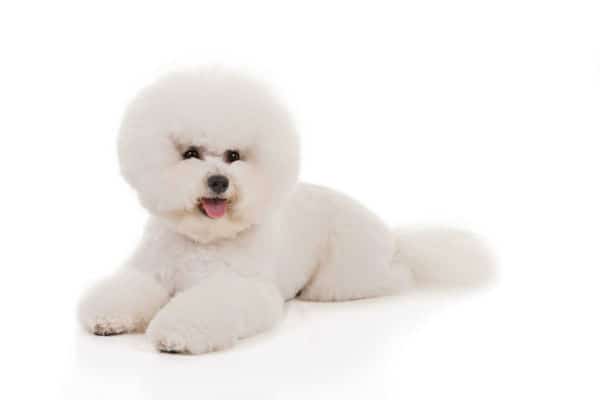The Bichon Frise needs a considerable amount of grooming to maintain its glamorous image. It has a dense and soft coat with a tendency toward corkscrew curls. It needs regular four- to six- week trimming and frequent baths to keep the coat in order and to give it the stunning appearance befitting the breed. This breed was once presented with only its muzzle and feet tidied up, but now the whole coat is frequently seen scissored.
Equipment needed: Long-bladed scissors, short-bladed scissors, bristle brush, large slicker brush, small slicker brush and steel combs with wide-set teeth and close-set teeth.
The coat needs plenty of attention, but these delightful little dogs are worth every second of your hard work.
- Be vigilant about removing tangles before bathing, as, once wet, mats are virtually impossible to remove without cutting. On occasions, it has been necessary to put a filthy, dirty Bichon into the bath and put in spray conditioner (anti-tangle or dematter) while the dog is soaking wet, and brush out the mats with the mat-breaker. This is avoidable if the dog is well combed before bathing.
- Try to split the felts by parting small sections at a time with your fingertips, and by spraying in an untangle product or a dematter.
- Brush with a slicker and comb through with a wide-toothed comb.
- Bathe regularly, at least once a month, in an appropriate shampoo, being careful to use a good-quality conditioner. Sometimes, add a teaspoonful of baby oil or similar to the conditioner to help prevent the coat from drying out.
- Rinse thoroughly. The Bichon may need two shampoos to get it clean.
- Not all groomers consider it necessary, but many choose to brush through the dog’s wet coat hair with a slicker brush before beginning blow-drying.
- Blow-dry the hair after using absorbent towels to lightly swab up excess moisture. Professional groomers and showdog owners will use a high-velocity hair-dryer to first remove excess moisture (it does not dry the coat). Then, a dryer with variable heat/ strength settings will be used to dry the coat while brushing.
- Starting with the tail, dry only small sections at a time, brushing continuously with a slicker or bristle brush. Next, brush and dry the legs, followed by the body hair and then the head and ears. Make sure you comb the hair away from the body. If you are aiming for the show-quality “powderpuff” effect, it is important to ensure that all the hair has been thoroughly groomed while drying, so the Bichon’s natural curl is brushed out into a soft-textured, straighter puff.
- Comb through the coat before trimming, taking care to brush the hair up, away from the coat. The coat should be combed constantly while trimming.
- The ears are so well blended, it is hard to distinguish them. It may be necessary to use thinning scissors underneath the ears if aiming for a show-standard finish.
- Trim excess hair from under the feet.
- Trim the hair from under and around the anus, leaving the tail hair long.
- Scissor the rear legs, always keeping the scissors parallel to the body. When viewed from behind, the dog’s legs should resemble a straight-sided, upside-down letter U.
- Next, trim the body hair. Begin with the sides and move down and underneath the body.
- Scissor the front legs to look straight when viewed from the front, but cylindrical (roller-shaped) from a distance. The feet are included in this line, hidden by the continuous line of leg hair.
- The hair on the topline — along the back from the shoulder to the tail — should be level, and closer than the hair on the neck. Scissor, following the line of the body, to give a round appearance, taking care to blend in well with the neck hair.
- If necessary, retrim the hindquarters and body hair to give a well-blended appearance.
- Excess hair should be removed from the inside of the dog’s ear leathers, using your fingers or blunt tweezers and removing only a little at a time. Blend in the remaining hair with the Bichon’s characteristic topknot.
- The hair over the eyes is combed forward and trimmed back to allow full view of the eyes. Keeping the scissor ends away from the dog’s eyes, start by removing the hair on the inside corners of the eyes.
- Neaten over the bridge of the nose, combing the remainder downward.
- Comb the topknot and trim to a smooth, rounded appearance, also trimming any hair falling over the top of the eyes.
- The line across the chin, incorporating the beard, is fairly straight. The beard hair should be blended with the ear furnishings, and the neck blended with the topline.
- Give a final comb through and check the dog’s nails, ears and teeth.
How to Groom a Bichon Frise was last modified: April 11th, 2019 by zsoltm1778

